Hf1−xSixO2 Nanocomposite Coatings Prepared by Ion-Assisted Co-Evaporation Process for Low-Loss and High-LIDT Optics
Abstract
1. Introduction
2. Materials and Methods
2.1. Sample Preparation and Annealing Methods
2.2. Characterization
3. Results
3.1. Optical Properties
3.2. Microstructure Properties
3.3. Absorption at 1064 nm
3.4. Application of the Hf1−xSixO2 Nanocomposites
4. Conclusions
- (1)
- For the optical properties, the refractive index and absorption coefficient were found to decrease with increasing silica content from 0% to 40%, except for the anomalous behavior of the compositions with 10% silica in some spectral bands, while the optical bandgap increases monotonically with increasing silica content. This demonstrates the advantages and potential of the Hf1−xSixO2 nanocomposites in tailoring the refractive index and increasing LIDT.
- (2)
- We analyzed the relationships between the SiO2 content and the microstructure at different annealing temperatures and found that the Hf1−xSixO2 nanocomposites changed from polycrystalline to amorphous with increasing SiO2 content. A SiO2 concentration of 20% or higher was sufficient to achieve a dense amorphous microstructure. The microstructure of the H1−xSixO2 nanocomposites with different SiO2 concentrations exhibited different evolution patterns during annealing. We proposed a phenomenological model to explain the microstructure evolution.
- (3)
- We explored the weak absorption at 1064 nm of all Hf1−xSixO2 nanocomposites with different SiO2 contents before and after annealing. SiO2 doping and high-temperature annealing substantially reduced the absorption of the film. When the annealing temperature reached 600 °C, all Hf1−xSixO2 nanocomposites exhibited relatively low absorption. However, the Hf0.80Si0.20O2 nanocomposites had the highest absorption of 18.5 ppm after annealing at 600 °C. We proposed a description of the substoichiometric defects and the dominant structural defects to illustrate the absorption evolution of the Hf1−xSixO2 nanocomposites with different SiO2 contents before and after annealing.
- (4)
- When the SiO2 concentration exceeded 30%, a dense amorphous structure with a relatively low roughness value and low absorption loss was maintained after thermal annealing. We prepared 1064 nm high-reflective coatings consisting of SiO2 and Hf0.700S0.30O2 and achieved low optical loss (15.1 ppm) and a high LIDT (67 J/cm2).
Author Contributions
Funding
Institutional Review Board Statement
Informed Consent Statement
Data Availability Statement
Conflicts of Interest
References
- Moses, E.I. Ignition on the National Ignition Facility: A path towards inertial fusion energy. Nucl. Fusion 2009, 49, 104022. [Google Scholar] [CrossRef]
- Adhikari, R.X. Gravitational radiation detection with laser interferometry. Rev. Mod. Phys. 2014, 86, 121–151. [Google Scholar] [CrossRef]
- Gallais, L.; Cheng, X.; Wang, Z. Influence of nodular defects on the laser damage resistance of optical coatings in the femto-second regime. Opt. Lett. 2014, 39, 1545–1548. [Google Scholar] [CrossRef] [PubMed]
- Zhang, J.; Wu, H.; Jiao, H.; Schröder, S.; Trost, M.; Wang, Z.; Cheng, X. Reducing light scattering in high-reflection coatings through destructive interference at fully correlated interfaces. Opt. Lett. 2017, 42, 5046–5049. [Google Scholar] [CrossRef] [PubMed]
- Tcheliebou, F.; Boyer, A.; Martin, L. Studies on MgO-stabilized zirconia thin films in the UV-visible region. Thin Solid Film. 1994, 249, 86–90. [Google Scholar] [CrossRef]
- Tokas, R.; Sahoo, N.; Thakur, S.; Kamble, N. A comparative morphological study of electron beam co-deposited binary optical thin films of HfO2:SiO2 and ZrO2:SiO2. Curr. Appl. Phys. 2008, 8, 589–602. [Google Scholar] [CrossRef]
- Gallais, L.; Commandré, M. Laser-induced damage thresholds of bulk and coating optical materials at 1030 nm, 500 fs. Appl. Opt. 2014, 53, A186–A196. [Google Scholar] [CrossRef]
- Zhang, X.M.; Wei, X.F.; Li, M.Z.; Yuan, Q.; Wang, W.Y.; Li, F.Q. Bidirectional amplifying architecture with twin pulses for laser fusion facilities. Laser Phys. Lett. 2013, 10, 115803. [Google Scholar] [CrossRef]
- Ouellette, M.F.; Lang, R.V.; Yan, K.L.; Bertram, R.W.; Owles, R.S.; Vincent, D. Experimental studies of inhomogeneous coatings for optical applications. J. Vac. Sci. Technol. A 1991, 9, 1188–1192. [Google Scholar] [CrossRef]
- Masse, J.P.; Szymanowski, H.; Zabeida, O.; Amassian, A.; Klemberg-Sapieha, J.; Martinu, L. Stability and effect of annealing on the optical properties of plasma-deposited Ta2O5 and Nb2O5 films. Thin Solid Film. 2006, 515, 1674–1682. [Google Scholar] [CrossRef]
- Wang, L.; Liu, H.; Jiang, Y.; Yang, X.; Liu, D.; Ji, Y.; Zhang, F.; Chen, D. Effects of hot-isostatic pressing and annealing post-treatment on HfO2 and Ta2O5 films prepared by ion beam sputtering. Optik 2017, 142, 33–41. [Google Scholar] [CrossRef]
- Jensen, L.; Mende, M.; Schrameyer, S.; Jupé, M.; Ristau, D. Role of two-photon absorption in Ta2O5 thin films in nanosecond laser-induced damage. Opt. Lett. 2012, 37, 4329–4331. [Google Scholar] [CrossRef]
- Genin, F.Y.; Stolz, C.J.; Kozlowski, M.R. Growth of laser-induced damage during repetitive illumination of HfO2/SiO2 mul-tilayer mirror and polarizer coatings. Proc. SPIE 1997, 2966, 273–282. [Google Scholar]
- Fornier, A.; Bernardino, D.; Lam, O.; Néauport, J.; Dufour, F.; Schmitt, B.R.; Mackowski, J.-M. High laser damage threshold HfO2/SiO2 mirrors manufactured by sputtering process. In Proceedings of the Third International Conference on Solid State Lasers for Application to Inertial Confinement Fusion, Monterey, CA, USA, 23 July 1999; Volume 3492, pp. 912–920. [Google Scholar] [CrossRef]
- Zhong, L.; Daniel, W.L.; Zhang, Z.; Campbell, S.A.; Gladfelter, W.L. Atomic Layer Deposition, Characterization, and Dielectric Properties of HfO2/SiO2 Nanolaminates and Comparisons with Their Homogeneous Mixtures. Chem. Vap. Depos. 2006, 12, 143–150. [Google Scholar] [CrossRef]
- Jensen, L.O.; Mende, M.; Blaschke, H.; Ristau, D.; Nguyen, D.; Emmert, L.; Rudolph, W. Investigations on SiO2/HfO2 mixtures for nanosecond and femtosecond pulses. In Proceedings of the Laser Damage Symposium XLII: Annual Symposium on Optical Materials for High Power Lasers, Boulder, CO, USA, 30 November 2010; Volume 7842, p. 784207. [Google Scholar] [CrossRef]
- Mende, M.; Jensen, L.O.; Ehlers, H.; Riggers, W.; Blaschke, H.; Ristau, D. Laser-induced damage of pure and mixture material high reflectors for 355nm and 1064nm wavelength. SPIE Opt. Syst. Des. 2011, 8168, 816821. [Google Scholar] [CrossRef]
- Mende, M.; Jensen, L.O.; Ehlers, H.; Bruns, S.; Vergöhl, M.; Burdack, P.; Ristau, D. Applying hafnia mixtures to enhance the laser-induced damage threshold of coatings for third-harmonic generation optics. SPIE Laser Damage 2012, 8530, 85300W. [Google Scholar] [CrossRef]
- Abromavičius, G.; Kičas, S.; Buzelis, R. High temperature annealing effects on spectral, microstructural and laser damage resistance properties of sputtered HfO2 and HfO2-SiO2 mixture-based UV mirrors. Opt. Mater. 2019, 95, 109245. [Google Scholar] [CrossRef]
- Jena, S.; Tokas, R.B.; Kamble, N.M.; Thakur, S.; Sahoo, N.K. Optical properties and laser damage threshold of HfO2-SiO2 mixed composite thin film. Appl. Opt. 2014, 535, 850–860. [Google Scholar] [CrossRef]
- Zeng, T.; Zhu, M.; Chai, Y.; Li, J.; Shao, J. Dichroic laser mirrors with mixture layers and sandwich-like-structure interfaces. Photon. Res. 2021, 9, 229. [Google Scholar] [CrossRef]
- Cheng, X.; Dong, S.; Zhi, S.; Paschel, S.; Balasa, I.; Ristau, D.; Wang, Z. Waterproof coatings for high-power laser cavities. Light. Sci. Appl. 2019, 8, 12. [Google Scholar] [CrossRef]
- Ai, W.; Xiong, S. Characterization of hafnia thin films made with different deposition technologies. In Proceedings of the XLIII Annual Symposium on Optical Materials for High Power Lasers, Boulder, CO, USA, 22 November 2011; Volume 8190, p. 81900J. [Google Scholar] [CrossRef]
- Ma, H.; Cheng, X.; Zhang, J.; Jiao, H.; Ma, B.; Tang, Y.; Wu, Z.; Wang, Z. Effect of boundary continuity on nanosecond laser damage of nodular defects in high-reflection coatings. Opt. Lett. 2017, 42, 478. [Google Scholar] [CrossRef] [PubMed]
- Park, J.-W.; Lee, D.-K.; Lim, D.; Lee, H.; Choi, S.-H. Optical properties of thermally annealed hafnium oxide and their correlation with structural change. J. Appl. Phys. 2008, 104, 033521. [Google Scholar] [CrossRef]
- Jena, S.; Tokas, R.B.; Rao, K.D.; Thakur, S.; Sahoo, N.K. Annealing effects on microstructure and laser-induced damage threshold of HfO2/SiO2 multilayer mirrors. Appl. Opt. 2016, 55, 6108–6114. [Google Scholar] [CrossRef] [PubMed]
- Optilayer. Available online: http://www.optilayer.com (accessed on 18 August 2020).
- Wang, W.H.; Chao, S. Annealing effect on ion-beam-sputtered titanium dioxide film. Opt. Lett. 1998, 23, 1417–1419. [Google Scholar] [CrossRef]
- Cody, G.D.; Tiedje, T.; Abele, B.; Moustakas, T.D.; Brooks, B.; Goldstein, Y. Disorder and the optical-absorption edge of hy-drogenated amorphous silicon. J. Phys. Colloq. 1981, 42, 301–304. [Google Scholar] [CrossRef]
- Das, N.C.; Sahoo, N.K.; Bhattacharyya, D.; Thakur, S.; Kamble, N.M.; Nanda, D. Correlation between local structure and refractive index of e-beam evaporated HfO2-SiO2 composite thin films. J. App. Phys. 2010, 1082, 023515. [Google Scholar] [CrossRef]
- Mero, M.; Liu, J.; Rudolph, W.; Ristau, D.; Starke, K. Scaling laws of femtosecond laser pulse induced breakdown in oxide films. Phys. Rev. B 2005, 71, 115109. [Google Scholar] [CrossRef]
- Liu, F.; Dong, S.; Zhang, J.; Jiao, H.; Ma, B.; Wang, Z.; Cheng, X. Interface and material engineering for zigzag slab lasers. Sci. Rep. 2017, 7, 16699. [Google Scholar] [CrossRef]
- Prajapati, C.S.; Sahay, P.P. Influence of in doping on the structural, optical and acetone sensing properties of ZnO nanopar-ticulate thin films. Mat. Sci. Semicond. Proc. 2013, 16, 200–210. [Google Scholar] [CrossRef]
- Jiang, S.; He, G.; Gao, J.; Xiao, D.; Jin, P.; Li, W.; Lv, J.; Liu, M.; Liu, Y.; Sun, Z. Microstructure, optical and electrical properties of sputtered HfTiO high-k gate dielectric thin films. Ceram. Int. 2016, 42, 11640–11649. [Google Scholar] [CrossRef]
- Obstarczyk, A.; Kaczmarek, D.; Wojcieszak, D.; Mazur, M.; Domaradzki, J.; Kotwica, T.; Pastuszek, R.; Schmeisser, D.; Mazur, P.; Kot, M. Tailoring optical and electrical properties of thin-film coatings based on mixed Hf and Ti oxides for optoelectronic application. Mater. Des. 2019, 175, 107822. [Google Scholar] [CrossRef]
- Zhang, J.; He, G.; Zhou, L.; Chen, H.; Chen, X.; Deng, B.; Lv, J.; Sun, Z. Microstructure optimization and optical and interfacial properties modulation of sputtering-derived HfO2 thin films by TiO2 incorporation. J. Alloys Compd. 2014, 611, 253–259. [Google Scholar] [CrossRef]
- Louis, B.; Krins, N.; Faustini, M.; Grosso, D. Understanding Crystallization of Anatase into Binary SiO2/TiO2 Sol/Gel Optical Thin Films: An in Situ Thermal Ellipsometry Analysis. J. Phys. Chem. C 2011, 115, 3115–3122. [Google Scholar] [CrossRef]
- Skrotzki, W.; Kegler, K.; Tamm, R.; Oertel, C. Recrystallization of Iron Aluminides. Mater. Sci. Forum 2004, 467, 525–530. [Google Scholar] [CrossRef]
- Khairnar, A.; Mahajan, A. Effect of post-deposition annealing temperature on RF-sputtered HfO2 thin film for advanced CMOS technology. Solid State Sci. 2013, 15, 24–28. [Google Scholar] [CrossRef]
- Wang, J.; Ponton, C.B.; Marquis, P.M. Abnormal grain growth in alumina-doped hafnia ceramics. J. Mater. Sci. 1994, 29, 3577–3590. [Google Scholar] [CrossRef]
- Stemmer, S.; Chen, Z.; Levi, C.G.; Lysaght, P.S.; Foran, B.; Gisby, J.A.; Taylor, J.R. Application of Metastable Phase Diagrams to Silicate Thin Films for Alternative Gate Dielectrics. Jpn. J. Appl. Phys. 2003, 42, 3593–3597. [Google Scholar] [CrossRef]
- Pu, Y.; Qiao, Z.; Zhang, M.; Lu, Z.; Qiu, F.; Lv, L.; Ma, P. Annealing effects on microstructure and laser-induced damage threshold of quasi-rugate filters. Opt. Express 2016, 24, 23044. [Google Scholar] [CrossRef]
- Jiao, H.; Cheng, X.; Liu, Y.; Lu, J.; Ma, B.; He, P.; Wang, Z. The effects of substrate temperatures on the structure and properties of hafnium dioxide (HfO2) films. Opt. Interf. Coat. 2010, 50, C309–C315. [Google Scholar] [CrossRef]
- Niu, X.; Jiao, H.; Bao, G.; Zhang, J.; Cheng, X.; Wang, Z. HfO2-SiO2 mixed film deposited by Ion Assisted Deposition Coevap-oration. Proc. SPIE 2017, 10447, 26. [Google Scholar]
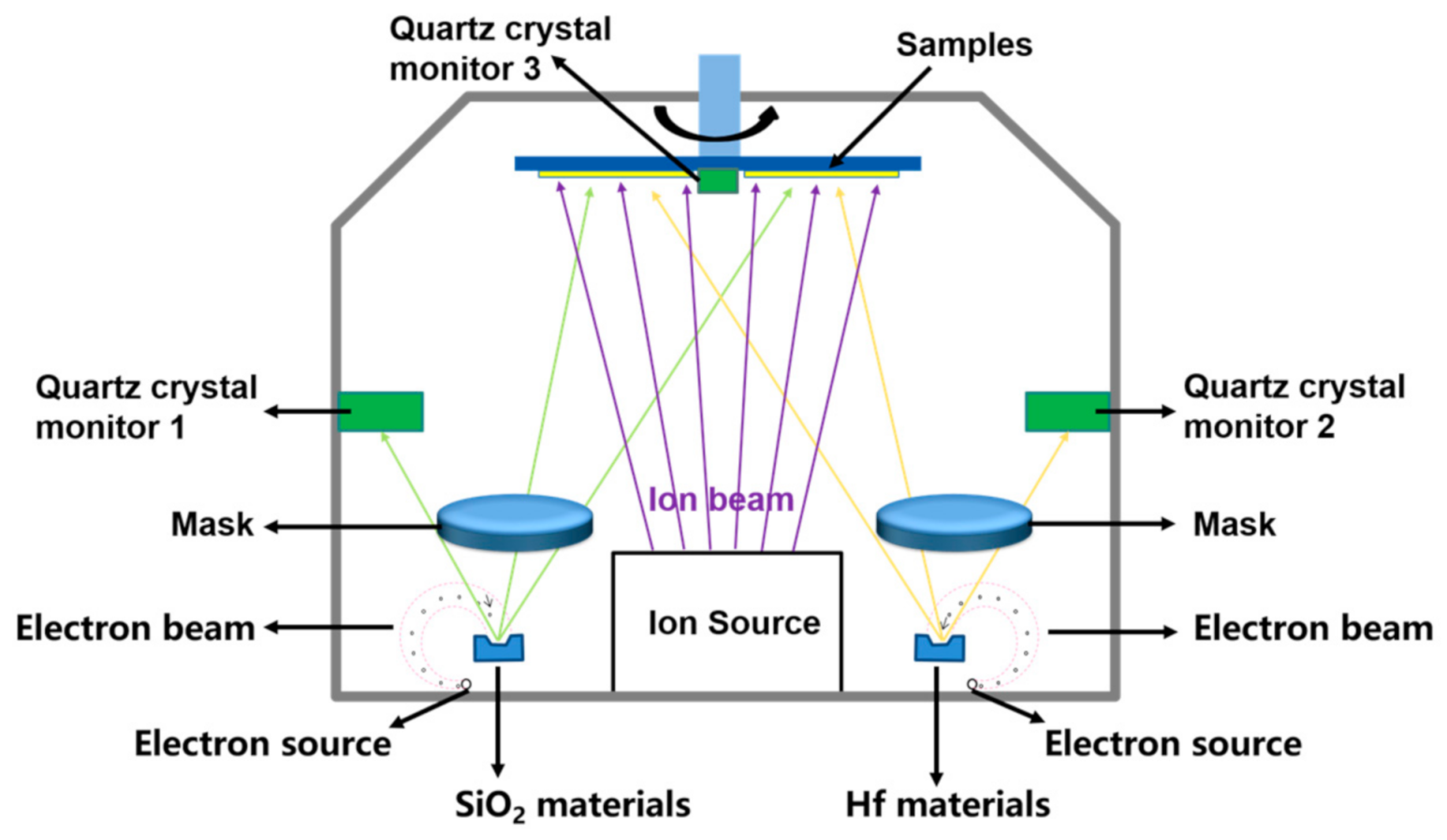
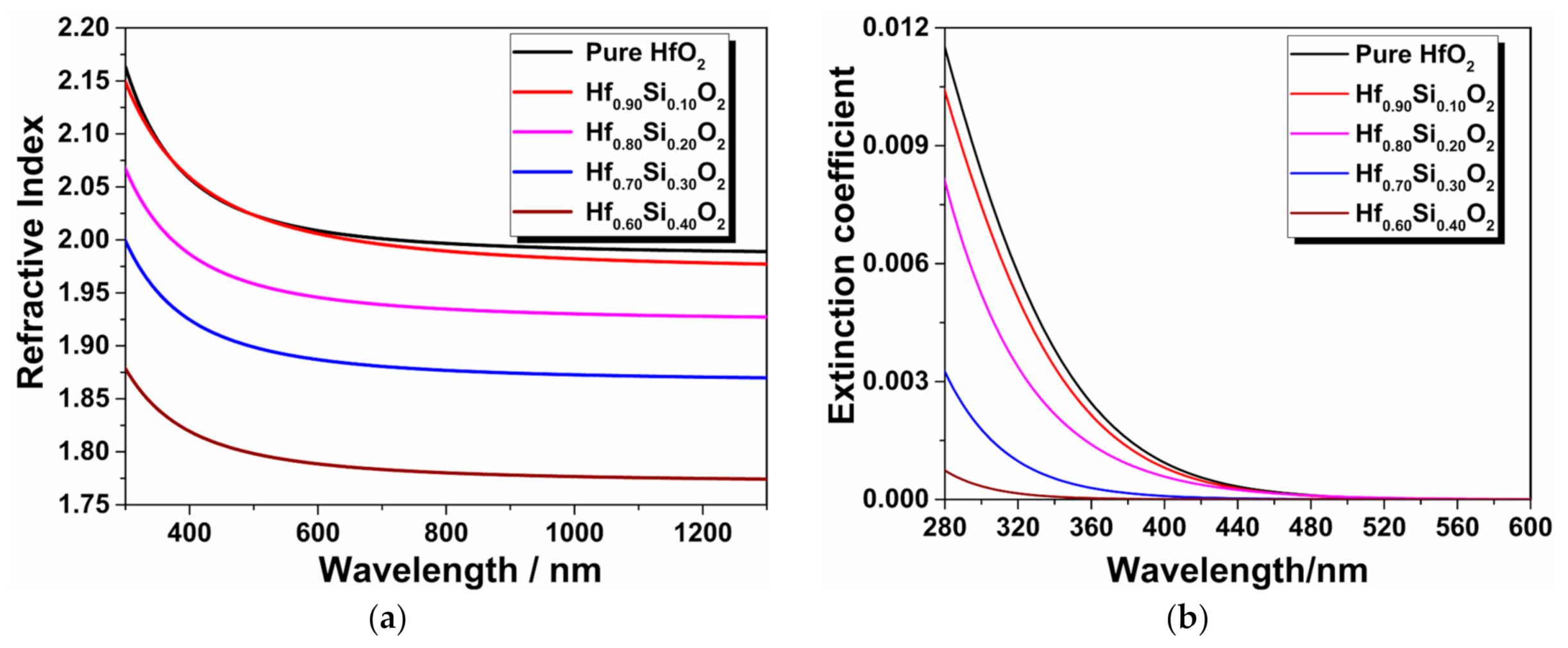
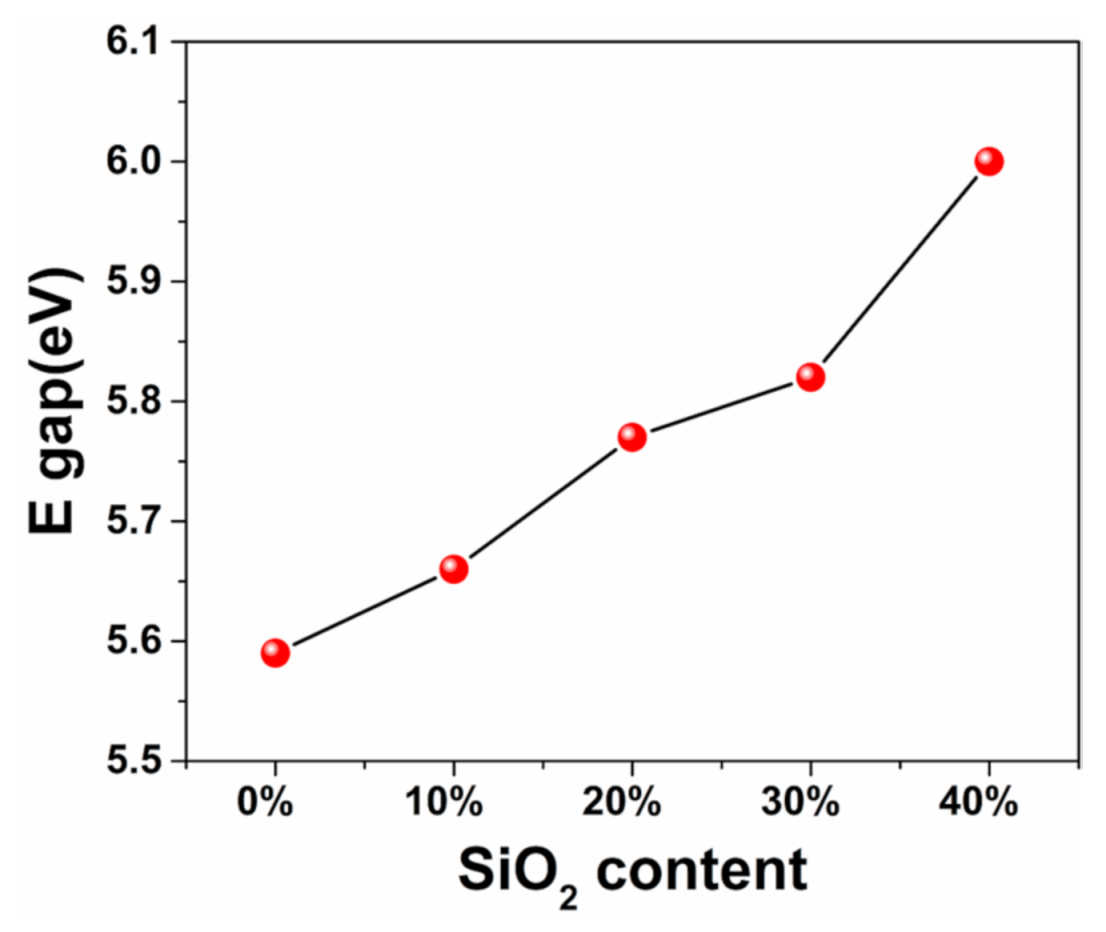
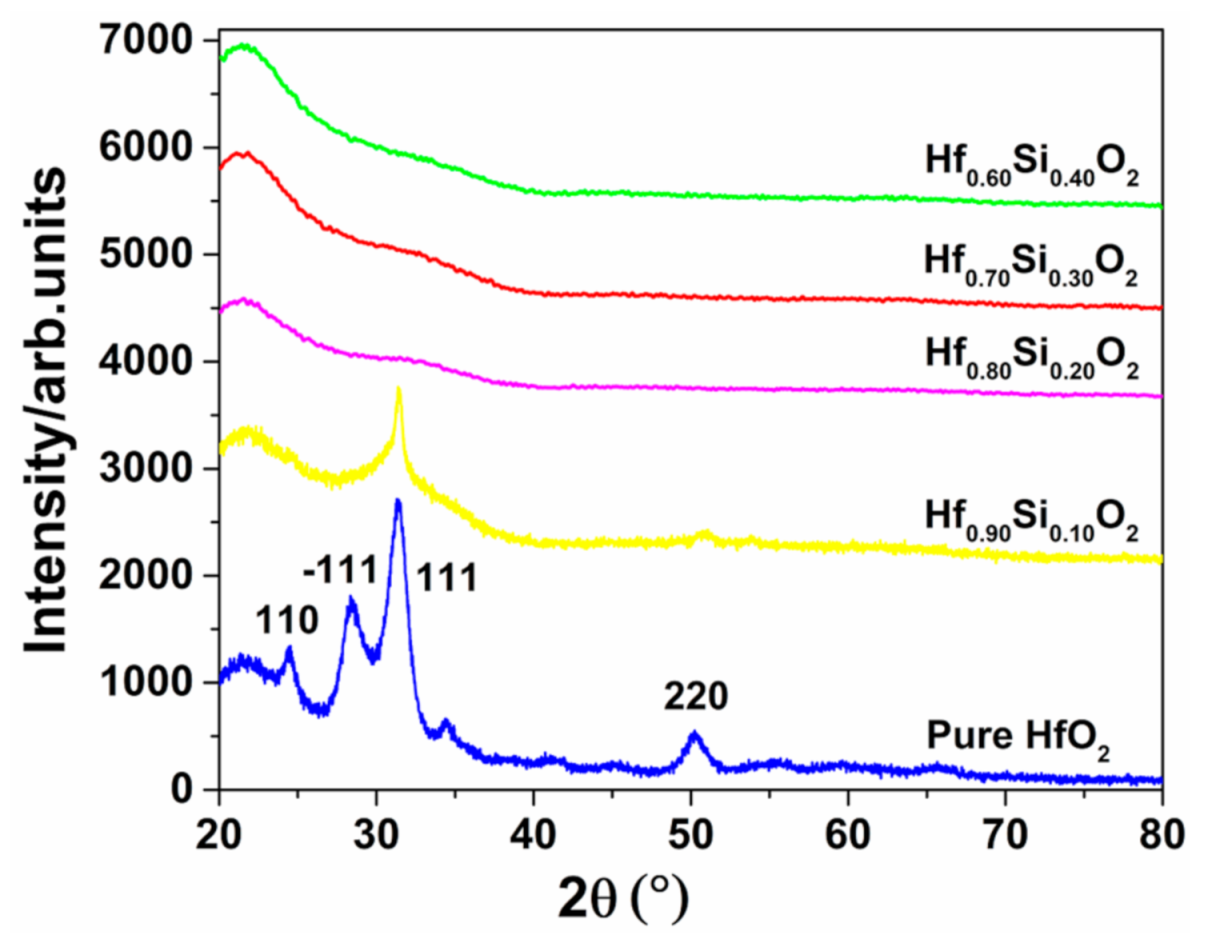
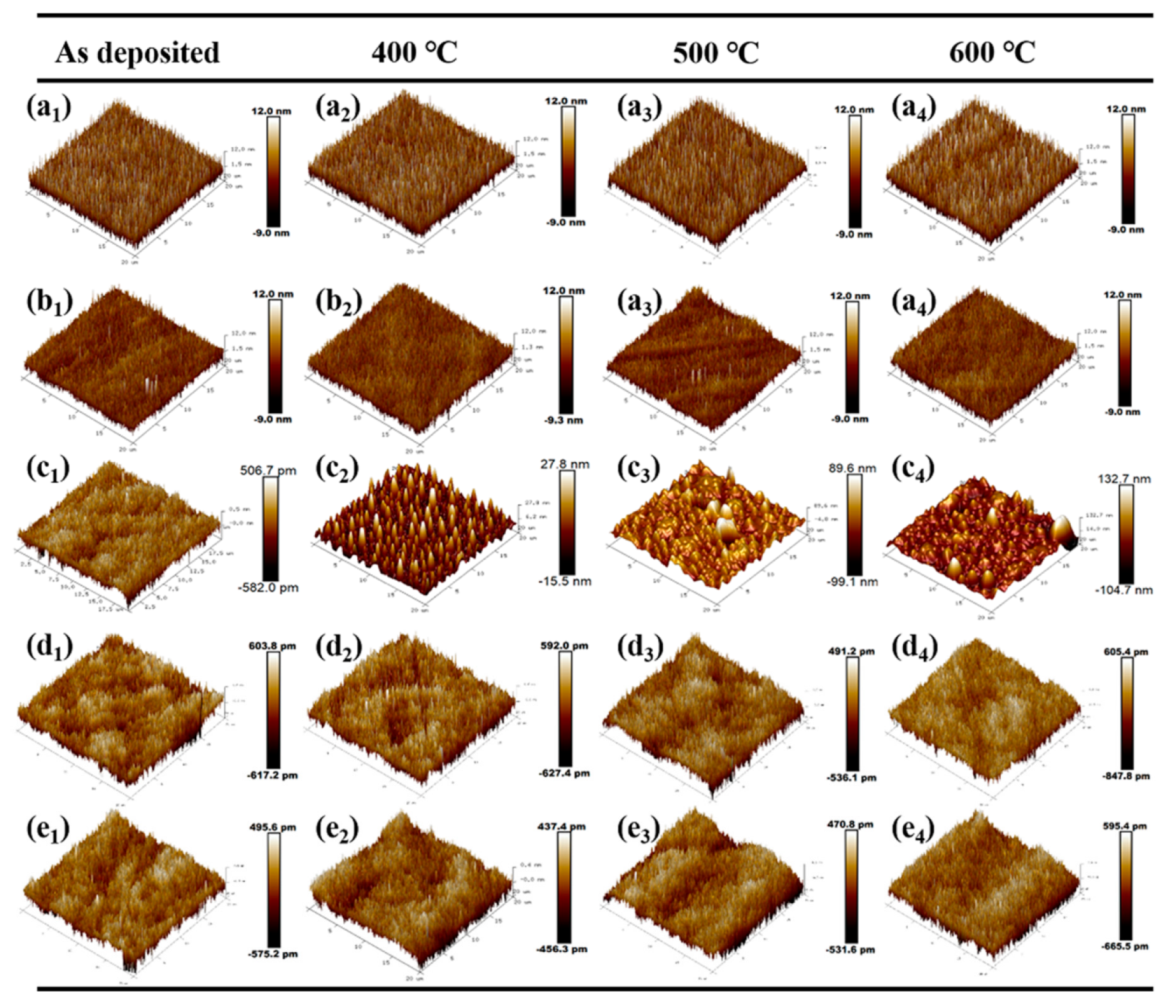

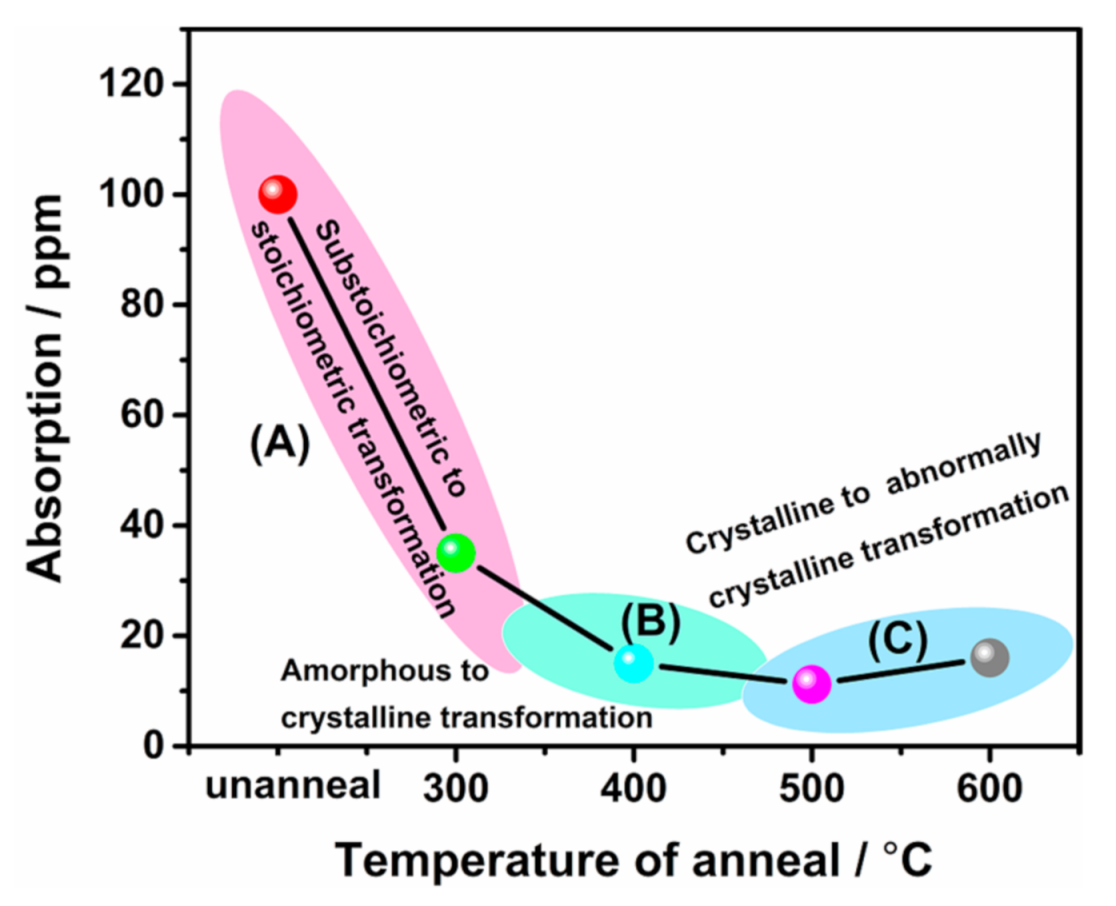
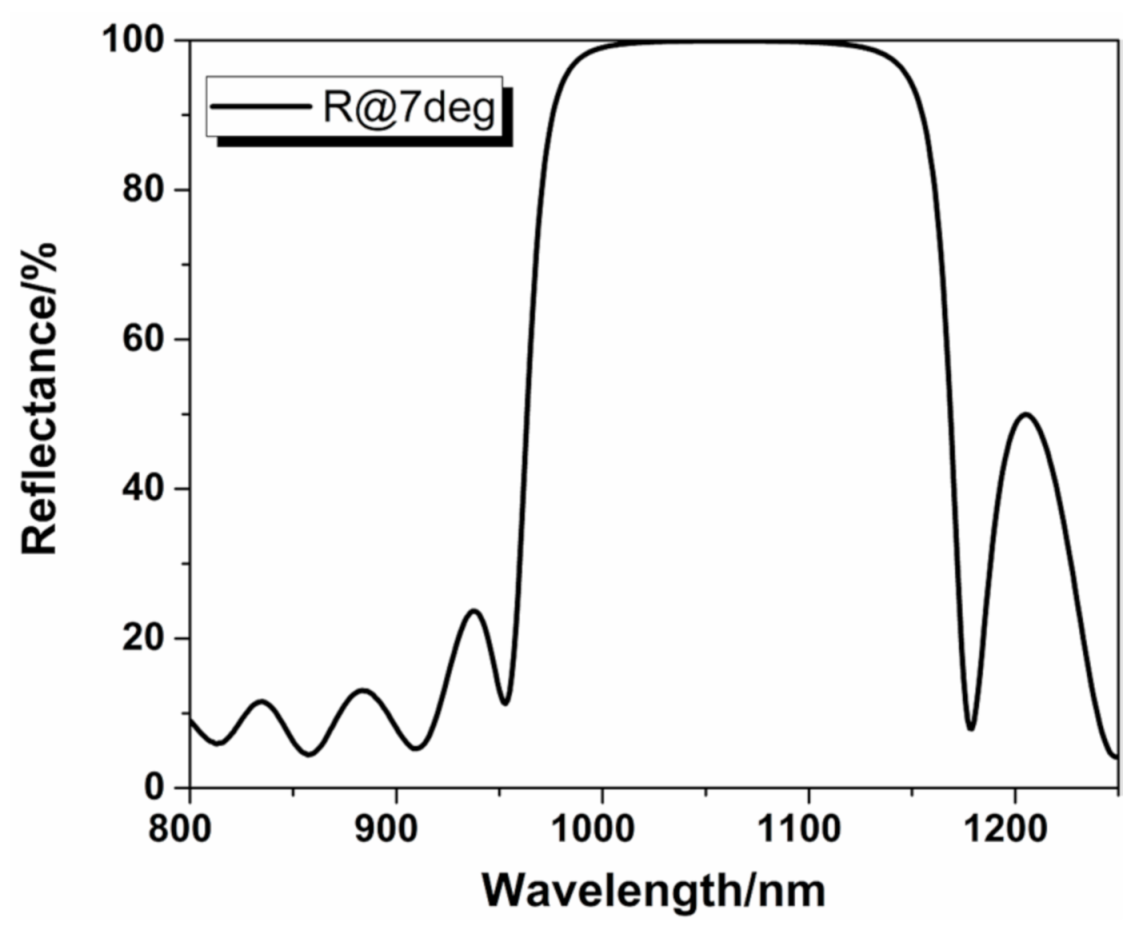
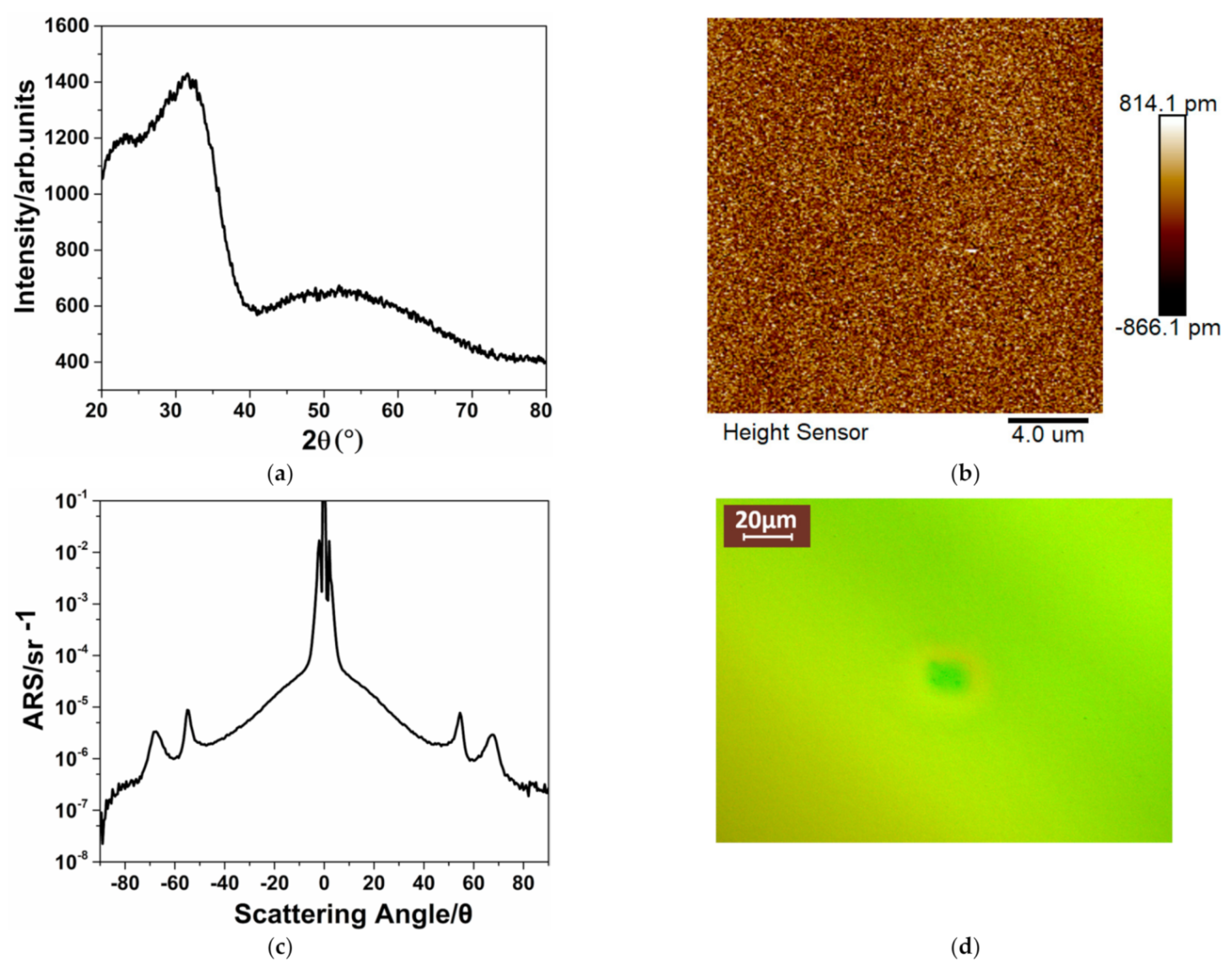
| Annealing Temperature | Roughness (nm) | ||||
|---|---|---|---|---|---|
| X = 0 | X = 0.10 | X = 0.20 | X = 0.30 | X = 0.40 | |
| As deposited | 3.92 | 2.63 | 0.153 | 0.186 | 0.203 |
| 300 °C | 3.68 | 2.54 | 0.173 | 0.201 | 0.218 |
| 400 °C | 3.83 | 2.59 | 6.12 | 0.232 | 0.201 |
| 500 °C | 3.88 | 2.61 | 19.1 | 0.197 | 0.197 |
| 600 °C | 3.75 | 2.35 | 25.7 | 0.225 | 0.216 |
| Annealing Temperature | Absorption (ppm) at 1064 nm | ||||
|---|---|---|---|---|---|
| X = 0 | X = 0.10 | X = 0.20 | X = 0.30 | X = 0.40 | |
| As deposited | 131.0 | 110.4 | 100.0 | 68.0 | 43.0 |
| 300 °C | 72.0 | 55.2 | 35.3 | 14.3 | 9.8 |
| 400 °C | 31.0 | 20.2 | 15.0 | 12.2 | 7.8 |
| 500 °C | 15.0 | 9.5 | 11.2 | 5.0 | 3.4 |
| 600 °C | 2.5 | 2.0 | 18.5 | 1.5 | 1.5 |
| Samples | Absorption/ppm | Scattering/ppm | Total Loss/ppm | RMS/nm | LIDT/J/cm2 |
|---|---|---|---|---|---|
| Hf0.70Si0.30O2−SiO2 HR coatings | 1.8 | 13.3 | 15.1 | 0.225 | 67 ± 2 |
Publisher’s Note: MDPI stays neutral with regard to jurisdictional claims in published maps and institutional affiliations. |
© 2021 by the authors. Licensee MDPI, Basel, Switzerland. This article is an open access article distributed under the terms and conditions of the Creative Commons Attribution (CC BY) license (https://creativecommons.org/licenses/by/4.0/).
Share and Cite
Jiao, H.; Niu, X.; Zhang, J.; Ma, B.; Cheng, X.; Wang, Z. Hf1−xSixO2 Nanocomposite Coatings Prepared by Ion-Assisted Co-Evaporation Process for Low-Loss and High-LIDT Optics. Materials 2021, 14, 2606. https://doi.org/10.3390/ma14102606
Jiao H, Niu X, Zhang J, Ma B, Cheng X, Wang Z. Hf1−xSixO2 Nanocomposite Coatings Prepared by Ion-Assisted Co-Evaporation Process for Low-Loss and High-LIDT Optics. Materials. 2021; 14(10):2606. https://doi.org/10.3390/ma14102606
Chicago/Turabian StyleJiao, Hongfei, Xinshang Niu, Jinlong Zhang, Bin Ma, Xinbin Cheng, and Zhanshan Wang. 2021. "Hf1−xSixO2 Nanocomposite Coatings Prepared by Ion-Assisted Co-Evaporation Process for Low-Loss and High-LIDT Optics" Materials 14, no. 10: 2606. https://doi.org/10.3390/ma14102606
APA StyleJiao, H., Niu, X., Zhang, J., Ma, B., Cheng, X., & Wang, Z. (2021). Hf1−xSixO2 Nanocomposite Coatings Prepared by Ion-Assisted Co-Evaporation Process for Low-Loss and High-LIDT Optics. Materials, 14(10), 2606. https://doi.org/10.3390/ma14102606









